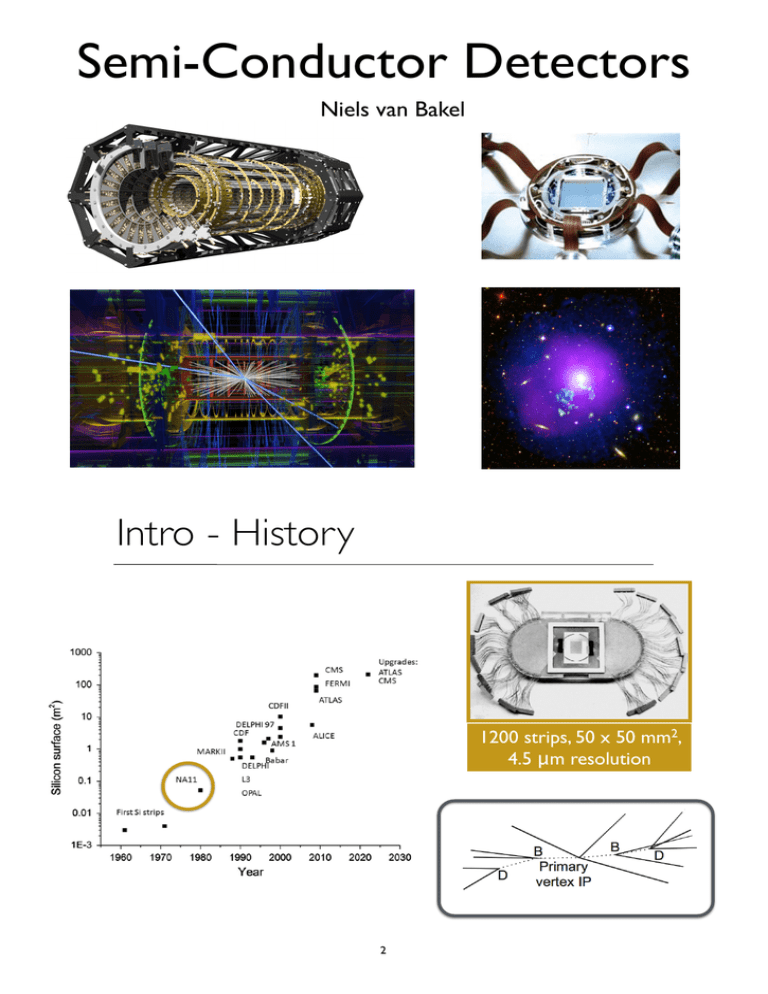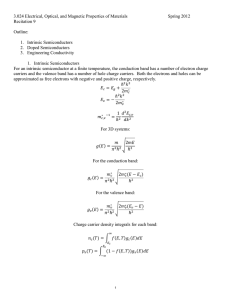Semi-Conductor Detectors
advertisement

Semi-Conductor Detectors Niels van Bakel Intro - History 1200 strips, 50 x 50 mm2, 4.5 μm resolution 2 Intro - Future http://benasque.org/2012imfp/talks_contr/307_Sergio.pdf 3 Intro - What I would like to achieve Particle tracking vs. Imaging detectors Mature technology Complex and large field Semi-Conductor Physics Silicon Detector principle Calculations - back of envelope Simulations (GEANT) -details State of the Art - Future 4 Silicon as detector material Abundant Conductance Expensive: purity & low-noise readout Proven technology Alternatives: Ge, Diamond, GaAs, CdTe Conductance:102 to 10−9 Ω−1cm−1 5 Silicon Si: 1s (2e-), 2s (2e-), 2p (6e-), 3s (2e-) filled 3p (2e-) ⟹ 2 out of 6 filled 6 Silicon - Energy band structure Germanium Silicon GaAs Conduction band Bandgap Valence band 7 Intrinsic Semi-conductor Properties 8 • Dispersion relation • Density of states • Fermi-Dirac distribution • Electron density Intrinsic Semi-conductor Properties Confusing: compared to previous fig • • • Carrier concentration in conduction and valence band: No impurities: m*e/m*h Si Ge GaAs 0.8 2.1 0.13 Yields the Fermi-level: 9 Silicon - Energy gap SiO2 Si 10 Al Intrinsic Semi-conductor Properties Atomic number Density [g/cm3] Radiation length [mm] Lattice constant [Å] Gap energy @ 300/0K [eV] ni @ 300K [cm-3] Electron mobility [cm2/(Vs)] Hole mobility [cm2/(Vs)] NC @ 300K [cm-3] NV @ 300K [cm-3] Max. electric field [Vμm-1] Intrinsic resistivity [Ω cm] Energy e/h pair [eV] Fano factor Energy loss MIP [MeV/cm] All numbers at 300K? Si 14 2.33 93.6 5.4307 1.124/1.170 1.45 x 1010 1350 450 3.22 x 1019 1.83 x 1019 30 230000 3.62 0.12 3.87 Ge 32 5.32 23 GaAs 31/33 5.32 23.5 0.66 (77K) 2.4 1013 36000 (77K) 42000 (77K) 1.424 5 107 >8000 400 50 2.9 (77K) 0.13 3.3 108 4.2 0.10 11 Recap - Silicon • Material: semi-conductor, used in industry, different materials for different applications • Silicon crystal: the energy levels are N-fold degenerate, in a crystal this leads to a forbidden gap (bandgap), for T=0 all electrons bound (in valence band) ⟹ insulator, for T>0 some electrons jump to conduction band ⟹ semiconductor. = weak conductivity • Band structure: ionization depends also on momentum transfer for Si & Ge, hence ionization energy larger than bandgap • Intrinsic semi-conductor: from solving wave equation for electrons in solids to the density of states of electrons (and holes), to Fermi level • • Difference insulator, semi-conductor, metal - energy gap Use/understand the properties for different materials 12 Doped Semi-conductors (ne ≠ nh) 13 Doped Semi-conductors D A Extrinsic region: n-type: n ≈ ND p-type: p ≈ NA [NA = 0; n » p] [ND = 0; p » n] Typical concentrations: Dopants: ≥ 1013 atoms/cm3 [Strong doping: 1020 atoms/cm3; n+ or p+] Compare to Si-density: 5⋅1023/cm3 14 Band model: n-doping in Si T=0 T>0 15 Resistivity • Resistivity • Mobility [Ω cm] [cm2/Vs] ~10 ns readout time in 100 μm thick Si • !intrinsic = 230 103 Ωcm E.g. ND ≫ ni Doping 0.2 ppb or 2 donor atoms per 1010 Si atoms! !doped = 463 Ωcm 16 The pn-junction e- ⇠ ⇢ h+ Intrinsic Si: free charge carriers but only ∼2 × 104 signal electrons ∼109 Built-in voltage 17 The pn-junction - Electric Characteristics ⇢ h+ / e- ⇠ y-axis is junction 18 The pn-junction: forward and reverse bias e- ⇠ 19 The pn-junction: I-V curve Characteristic I(V) curve of a diode 20 Basic Semiconductor Detector Depletion width Full depletion voltage for w = D Capacitance of depleted detector 21 Recap - Semiconductor detector • Doped semi-conductor: donors & acceptors, additional states in the forbidden region NA and ND (Fermi level changes), effect of impurities, changes in energy needed to excite electron • • • Band model • Basic semi-conductor detector Resistivity pn-junction: built-in voltage, electric characteristics, biasing, leakage current 22 LHCb Vertex detector 23 The pn-junction - Si diode Leakage current with ni(T) defined by the life time of the impurities Nt 24 End first half 25 Strip & pixel sensors 26 Signal generation MIP 27 Noise contributions • Shot noise - leakage current • Thermal noise - bias resistor • Thermal noise - strip resistance • Load capacitance 28 Ionisation yield - energy resolution Energy resolution: Intrinsic resolution of sensor At T = 300 K Since both fluctuations in lattice excitations and in ionization are related and this reduces the fluctuations in the charge signal. 29 Position resolution - S/N • • Segmentation into strips, pads, pixels … • Improve resolution: calculate center of gravity • Delta electrons limit position resolution due to shift of center of gravity Geometric resolution 30 Electric field 31 Charge collection • Diffusion • Drift Use depletion width to get collection time Assume constant mobility (Partial) depleted •Electrons: •Holes: 32 Over depleted


